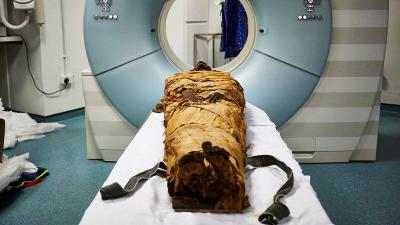In a first-of-its-kind experiment, a group of scientists in early 2020 succeeded in "hearing" the voice of an Egyptian priest who died more than 3,000 years ago. The experiment was conducted on the mummified body of a man named "Nesiamun," who served as a priest in the Temple of Amun-Ra at the Karnak complex in Thebes. The man, who lived during the reign of Pharaoh Ramses XI between 1099 – 1069 BC, was also a high-ranking scribe. Studies conducted on Nesiamun's mummy, preserved in Britain at the Leeds Museum, revealed that he suffered from dental and gum diseases and died at the age of about 50, possibly due to complications related to those issues.
After the priest's death, he was embalmed according to prevailing traditions to ensure he could live in the afterlife. Notably, Nesiamun's mummy is considered one of the best-preserved mummies in the world, which encouraged the unique experiment. On his sarcophagus, inscriptions expressed his plea to the gods to restore his ability to speak so he could speak for himself and defend his right to eternal life.
In addition to Nesiamun's urgent desire to regain his voice, inscribed on his sarcophagus, British scientists found in the excellent condition of the ligaments and other speech organs of the mummy a suitable opportunity to simulate his voice and make it heard again as part of a project dubbed "Voices from the Past." David Howard, a professor at the University of London specializing in human speech study and modeling vocal tracts, commented that Nesiamun needed a strong voice to perform rituals, including singing, which persuaded the team to select this priest for the experiment.
The team prepared for the experiment by conducting a CT scan of the mummy to visualize the vocal apparatus, placement of the respiratory system, skeletal structures, and soft tissues, with this data being utilized in the experiment. In the experiment, scientists used medical scanners and 3D printing technology, also employing an electronic larynx and speakers. These technologies allowed for the reconstruction of a short sound bite.
David Howard, one of the participants in the experiment, explained: "We reconstructed the correct sound based on the current condition of the mummy, but we do not expect a perfect match in speech, given the poor condition of the tongue." The team conducting the experiment also noted that a single model is not sufficient for assembling complete words or sentences, yet they pointed out that a practical first step has been taken in this direction.
Though the experiment seems modest, it was the first time an ancient human voice had been successfully recreated. Scientists acknowledge the challenges in accurately replicating the voice of the pharaonic priest who lived 3,100 years ago. Despite the technical difficulties faced by those conducting the experiment, they believe that someday the voices of priests like Nesiamun and other mummies could be restored as suitable technologies evolve. Such experiments are also extremely useful in improving the speech of AI-equipped robots. John Scowfield, an archaeologist at the University of York and a participant in the study, emphasized the importance of such experiments, stating: "There is nothing more personal than someone's voice. Hearing a voice after such a long time is an unforgettable experience. Thanks to this new method, historical figures like Nesiamun come back to life. This approach can also assist in better exploring historical heritage."




